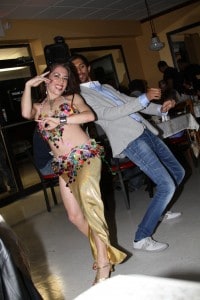
A change in latitude brings a change in attitude. What happens when you leave the diverse, multi-cultural belly dance scene of the New York metro area and find yourself in a smaller, younger, more fusion-based market without a teacher and without many opportunities to take workshops in the more classic and folkloric styles?
You save your money, honey. (So you can travel for workshops). And in the mean time, you get creative, set goals, and use your time wisely.
For better or worse, I’ve accepted that from this point forward, I will have to find ways to thrive and grow between workshops as a “self-taught” dancer. No, scratch that. A self-starting dancer. I hate the term “self-taught,” because it implies that I wasn’t really educated in the first place. That is far from the truth. My first dance-moms taught me very well!
Self-study sometimes gets a bad rap in the belly dance community, because we’re too intimately familiar with its Worst Case Scenario: the dancer who watches a couple of YouTube clips, says “I can do that!” and starts marketing herself for weddings. Truth is, many respectable dancers have had to turn to self-study, to varying degrees, and for various reasons. Money is tight for a lot of us. (See: Bhuz discussions on low attendance to Mahmoud Reda’s US tour). Some dancers have spouses in the military and frequently relocate, sometimes to desolate places. And in many markets, there aren’t enough instructors equipped to teach advanced concepts to pro-level students, which leads dancers to create their own path – for better and for worse.
When you go your own way, you can either stagnate, innovate or go deeper within the culture of the dance. I choose to go deeper. At the end of the day, I think it’s easier to say, “I’ve learned everything I can, so now I’m going to mix in a bunch of different things and create something new” than it is to say, “Something tells me I’ve barely scratched the surface. Let’s see what we can find.” I started with a pretty solid pan-Arabic repertoire of Egyptian, Lebanese, Turkish, Greek and American Cabaret styles. Now, I’m getting more folkloric and learning more about the music and social context of these dances.
The world is your classroom if you see it that way. Some of the best learning experiences are the ones that don’t cost a thing. This requires childlike curiosity, an open mind and a great deal of humility. Recently, I’ve opened my mind to observing how non-professional Arabs dance in social situations, both on YouTube and, better yet, at my own gigs. I devote hours of time each day to listening to classic Arabic music and learning about different genres and composers. I’ve started asking lots of questions. (Honest to God, this doesn’t make you look dumb. It shows that you’re sincere). This past Friday at one of my restaurant gigs, I befriended a cool Saudi dude named Faisal, who borrowed my sword and did some traditional Saudi stuff with it between my sets. I asked him to explain what I just saw and walked away with some fresh new insight, straight from the source. I learned more from talking to my new buddy in 5 minutes than I did in some workshops on the subject.
There’s nothing wrong with going straight to the source and keeping it real. Before belly dance became the competitive sport that many see it as today, it was a fun-loving, down-home folk dance passed along through generations. Movements were created, shared, refined, embellished and treasured in the home and in celebrations long before they were dissected in a classroom and choreographed for the stage. While paths have diverged, you can never get too earthy or too funky if you perform at social events and fancy yourself to be an authentic dancer.
Now, before I get a letter from the Belly Dance Police (which tends to happen when I blog about things other than my new costumes or what I ate for breakfast), the purpose of this post was not to trivialize the role of teachers or encourage anarchy in the belly dance community. If you have access to a great teacher, keep up your studies! If you have lots of great teachers and workshops in your backyard, treasure it! But if you don’t, then this is not the kiss of death. Even if you have a regular teacher and lots of workshop opportunities in your town, there’s always something you can learn outside the classroom.
Learning experiences are yours for the taking. You just have to ask.
About Carrara: Carrara is a professional belly dancer offering elegant, authentic entertainment for weddings and social events in Orlando and beyond. Multi-cultural weddings and events are her specialty! To learn more, check out her Booking or Weddings page, or follow her on Facebook.
